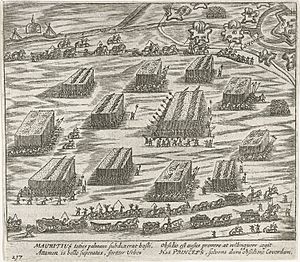Siege of Coevorden (1593) facts for kids
Quick facts for kids Siege of Coevorden (1593–94) |
|||||||
|---|---|---|---|---|---|---|---|
| Part of the Eighty Years' War & the Anglo–Spanish War | |||||||
 Relief of Coevorden by Maurice of Orange, 1594 |
|||||||
|
|||||||
| Belligerents | |||||||
| Commanders and leaders | |||||||
| Strength | |||||||
| 12,000 infantry 2,000 cavalry |
8,000 | ||||||
| Casualties and losses | |||||||
| Light | Heavy | ||||||
The Siege of Coevorden was a long battle for the city of Coevorden in the Netherlands. It lasted for 31 weeks. Spanish General Francisco Verdugo led the attack. This event was part of two bigger wars: the Eighty Years' War and the Anglo–Spanish War. The siege started in October 1593. But cold weather and a lack of food forced the Spanish to stop for winter. The fight began again in March 1594. On May 6, 1594, Maurice of Orange arrived. He brought an army of Dutch and English soldiers. This forced the Spanish army to leave, giving the Dutch and English a victory.
Contents
Why Coevorden Was Important
The Spanish army, called the Army of Flanders, was trying to control the Netherlands. But Dutch resistance made it hard. At this time, Spain was also busy fighting in France. This gave the Dutch and English a chance to attack. Their leaders were Maurice of Nassau and Francis Vere.
Maurice used smart battle plans. He built strong defenses and controlled key areas. Because of this, many towns fell to the Dutch and English in the 1590s. Coevorden was one of these towns. It had been captured in September 1592. This cut off a main Spanish supply route to Groningen. The capture of another town, Geertruidenberg, in 1593, cut off Groningen even more.
Francisco Verdugo was the Spanish leader in the area. He knew Coevorden was very important. It was key for Spain to control the northern Netherlands. It also helped Spain keep its hold on Drenthe. So, Verdugo was determined to take it back. In 1593, he started his plan. He attacked from Groenlo and took the town of Gramsbergen. He also built small forts in other places.
Verdugo tried to build a road through Drenthe. But William Louis, a Dutch leader, stopped him. The road was destroyed and blocked. Meanwhile, the Dutch soldiers in Coevorden got ready. Their governor, Caspar van Eussum, made sure they had enough food and ammunition. They were ready for a Spanish attack.
The Battle for Coevorden
First Attack: October 1593
Verdugo's army reached Coevorden in October 1593. They built a large dirt wall, or dike, to block the city. This created a tight blockade. But Verdugo did not know the local weather. His soldiers faced many problems. They lacked fuel and food. Many soldiers got sick and died. A lot of them also ran away. One group of 500 soldiers became only 100.
The sick soldiers spread disease to nearby villages. Whole families became ill and died. But the Dutch soldiers inside Coevorden were well-supplied. Their defenses were strong. The blockade did not work, but it cost Verdugo's army a lot.
By November, Verdugo realized he did not have enough supplies. Winter was coming. He had no choice but to pull his army back. The Dutch knew this but did not attack them as they left. Both sides went into winter break.
Second Attack: March 1594
Even though the Spanish left, they kept a close watch on Coevorden. They still tried to block supplies. But some food and more soldiers still managed to get into the city.
In March 1594, Verdugo returned to Coevorden. He had 8,000 soldiers, including 2,000 on horseback. They surrounded the city and demanded that the Dutch surrender. But Van Eussum refused. He hoped help would arrive soon. The Spanish began digging trenches and building strong points around the city.
Help Arrives
When Maurice of Orange heard about the siege, he moved quickly. He gathered his army, which included 5,000 English and Scottish soldiers led by Francis Vere. They marched from Zwolle towards Coevorden.
Count William Louis helped too. He had fortified an area called the Bourtange Marsh. This allowed Maurice to move quickly and surprise Verdugo. William Louis soon joined Maurice and Vere. Their combined force had about 9,600 soldiers and 1,900 cavalry.
Another Dutch leader, Count Philip of Hohenlohe-Neuenstein, was sent south. He had 20 Dutch companies. His job was to stop Spanish reinforcements. These Spanish troops, led by Frederik and Herman van den Bergh, numbered about 8,000 men.
Maurice's army soon got close to Coevorden. They started digging trenches in front of the Spanish. Verdugo saw their position. He realized the Dutch and English were too strong. They had also cut off his supply lines.
On the night of May 7, the Spanish army left their camp. They burned anything they did not need. Then they retreated from Coevorden. The long siege was finally over.
What Happened Next
After leaving Coevorden, Verdugo split his army. This was to confuse the Dutch and English if they tried to chase him. Most of his soldiers went to Groningen. The rest headed towards Oldenzaal and then to Spanish-held Lingen.
With Coevorden safe, Maurice had a choice. He could either attack Groningen right away or drive the Spanish out of the Twente region. The Dutch leaders wanted to go for Twente. But William Louis and Vere thought attacking Groningen made more sense. After much discussion, Maurice decided to attack Groningen. This led to its capture later that year.
Coevorden remained under Dutch control for the rest of the war.
A Lasting Mark
The dirt wall, or dike, that the Spanish built during the siege is still there today. It is now called the Spanjaardsdijk, which means "Spaniards' Dike."

